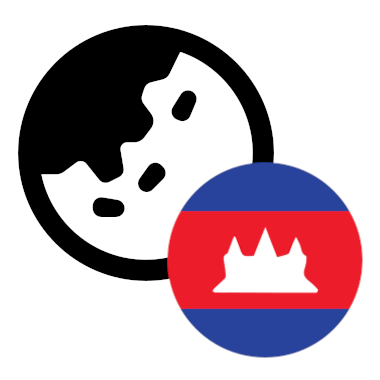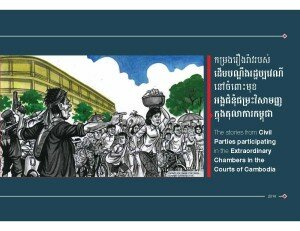
This storybook has been compiled by the Cambodian Human Rights Action Committee (CHRAC), a coalition of 21 Cambodian NGOs and Associations working in the fields of human rights, democracy, rule of law, and peace in the Kingdom of Cambodia.
This Civil Party Storybook is an expanded and updated version of “the Story and Testimony of Civil Parties in Case 002/01 before the ECCC” which CHRAC published in June 2013.
This book includes all of the Civil Party stories from the old storybook; as well as the additional stories of new civil parties with the illustrations relating to what happened during that time.
Book:
The stories from Civil Parties participating in the Extraordinary Chambers in the Courts of Cambodia
TEACHER’S GUIDEBOOK
THE TEACHING OF “A HISTORY OF DEMOCRATIC KAMPUCHEA (1975-1979)”
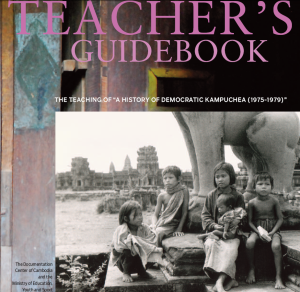 For the first time in three decades, the veil of silence that has plagued Cambodian schools will finally be lifted, allowing students and teachers to speak about and understand the Cambodian genocide of 1975–79. It is a monumental time in our nation’s history. Our new textbook and genocide curriculum will educate our youth, as well as simultaneously provide a platform for dialogue and discussion in which all Cambodians can take part. By facing this dark chapter in our history, we can begin to recognize the painful struggles of our family members and friends.
For the first time in three decades, the veil of silence that has plagued Cambodian schools will finally be lifted, allowing students and teachers to speak about and understand the Cambodian genocide of 1975–79. It is a monumental time in our nation’s history. Our new textbook and genocide curriculum will educate our youth, as well as simultaneously provide a platform for dialogue and discussion in which all Cambodians can take part. By facing this dark chapter in our history, we can begin to recognize the painful struggles of our family members and friends.
Book:
TEACHER’S GUIDEBOOK
THE FORCED TRANSFER:
The Second Evacuation of People During the Khmer Rouge Regime
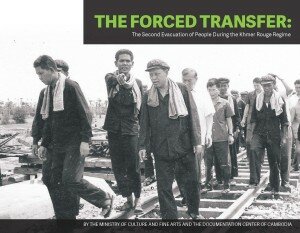 During the Democratic Kampuchea regime, our country suffered enormous cultural losses. Music, art, religion, and custom were sacrificed on the altar of a warped regime that had no regard for humanity, let alone the individual human being. Children were taken from their parents, husbands were separated from their wives, and families were broken apart. Cities and towns were emptied, and throughout the country, people were forced to travel, often times on foot, with nothing but the possessions they could carry. Ultimately millions of Cambodian people died during this regime.
During the Democratic Kampuchea regime, our country suffered enormous cultural losses. Music, art, religion, and custom were sacrificed on the altar of a warped regime that had no regard for humanity, let alone the individual human being. Children were taken from their parents, husbands were separated from their wives, and families were broken apart. Cities and towns were emptied, and throughout the country, people were forced to travel, often times on foot, with nothing but the possessions they could carry. Ultimately millions of Cambodian people died during this regime.
It is in this sense, the Khmer Rouge committed both human and cultural genocide.
This exhibition on forced transfer gives us an opportunity to reflect on certain aspects of this human and cultural genocide. Reflection on the past is a crucial task for all post-conflict countries because a country that cannot face the problems of its past will never have the courage and fortitude to face the problems of the present and future.
Report:
The Second Evacuation of People During the Khmer Rouge Regime
Out-of-Pocket and Catastrophic Expenditure on Health in Cambodia (2011)
Cambodian Demographic Health Survey 2005 and
Socio-Economic Surveys 2004 & 2007 Analysis
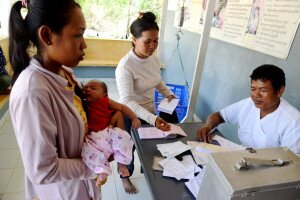 Seeking health care when needed without financial burden is at the heart of the principles embodied by the concept of universal health coverage. However, to make this concept a reality, countries have to undertake a reform of their social health protection policies. Such reforms need to be informed by reliable evidence on the needs of populations and vulnerable groups.
Seeking health care when needed without financial burden is at the heart of the principles embodied by the concept of universal health coverage. However, to make this concept a reality, countries have to undertake a reform of their social health protection policies. Such reforms need to be informed by reliable evidence on the needs of populations and vulnerable groups.
The present report looks at key indicators of the financial burden and associated health-seeking behaviour of various socioeconomic groups in Cambodia before the implementation of the Second Cambodian Health Strategic Plan (HSP2) in 2008. Using data from the previous Cambodian Socio-Economic Surveys (CSES) in 2004 and 2007, and the Cambodian Demographic Health Survey (CDHS) 2005, it illustrates the challenge that the Royal Government of Cambodia faced with its health partners in reducing out-of-pocket health expenditures and providing all its citizens with access to quality health services.
The analysis used robust and internationally recognised methods to quantify catastrophic expenditures and impoverishment resulting from seeking health care. It also examined the determinants of these indicators, and discussed the associated policy implications.
The CDHS 2005 analysis shows the need for increased health care access among the poorest groups of the population, as well as for old people, women and children under 5 years old. It confirms the important role of private providers in the delivery of services, but also in the financial landscape, with the great majority of health care visits and expenditures channelled to the private sector. Direct costs related to seeking care, such as transportation, were also significant, representing on average over 10% of household spending on health.
The CSES analysis provides a similar picture, but also illustrates how catastrophic expenditures, debt and impoverishment from health care are a risk for all economic groups, particularly those in rural areas or as a result of hospitalisation of a family member.
The vision of the Royal Government of Cambodia and the Ministry of Health to progress towards universal health coverage is shared by the Federal Republic of Germany, which provides technical support in this endeavour through the Cambodian-German Social Health Protection Project implemented by Deutsche Gesellschaft für Internationale Zusammenarbeit (GIZ).
Report:
Cambodian Demographic Health Survey 2005 and Socio-Economic Surveys 2004 & 2007 Analysis – english
Cambodian Demographic Health Survey 2005 and Socio-Economic Surveys 2004 & 2007 Analysis – khmer
Out-of-Pocket and Catastrophic Expenditure on Health in Cambodia (2012)
Cambodian Socio-Economic Surveys 2004, 2007 & 2009 Analysis
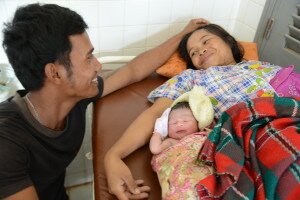 Information on health care costs, such as the burden of out-of-pocket household health spending and the extent of catastrophic health expenditures is essential for monitoring programmes, but also for guiding interventions, creating policy dialogue, and instituting reforms to achieve universal health coverage. Using robust and recognised methodologies, the following report presents a quantitative analysis of such indicators.
Information on health care costs, such as the burden of out-of-pocket household health spending and the extent of catastrophic health expenditures is essential for monitoring programmes, but also for guiding interventions, creating policy dialogue, and instituting reforms to achieve universal health coverage. Using robust and recognised methodologies, the following report presents a quantitative analysis of such indicators.
It uses a secondary statistical analysis of data from the Cambodian Socio-Economic Surveys (CSES) in 2004, 2007 and 2009 to illustrate the positive trend in access to health services, especially for the poor over that time. The analysis also points to the added value of the strategic interventions delineated by the Second Cambodian Health Strategic Plan (HSP2) for the years 2008-2015, and raises policy implications for further developing social health protection mechanisms for all Cambodians.
Between 2004 and 2009, all economic population groups reported a significant improvement of their health status, and more people sought medical care when sick. At the same time, overall out-of-pocket expenditures on health care rose significantly from KHR 59,640 to KHR 117,852 per person annually. However, average heath care bills also more than doubled. This rapid inflation was counterbalanced by increases in income during the same period. As a result, there was a significant decrease in catastrophic health expenditures, from 6.02% to 4.27% of all households spending more than 40% of their capacity-to-pay on health. This positive result is also partially explained by the government’s efforts to extend social health protection to the poorest people. However, the risk of impoverishment and indebtedness from high health care costs remains a reality for almost all Cambodians, particularly for old people and people in need of hospital care. These results underline the importance of advancing the agenda for universal health coverage in Cambodia as a way to foster economic, social and human development.
The vision of the Royal Government of Cambodia and the Ministry of Health to progress towards universal health coverage is shared by the Federal Republic of Germany, which provides technical support in this endeavour through the Cambodian-German Social Health Protection Project implemented by Deutsche Gesellschaft für Internationale Zusammenarbeit (GIZ).
Report:
Cambodian Socio-Economic Surveys 2004, 2007 & 2009 Analysis – english
Cambodian Socio-Economic Surveys 2004, 2007 & 2009 Analysis – khmer
Actuarial Review of The NSSF Employment Injury Branch and Assessment of Social Health Insurance
for The National Social Security Fund (NSSF) and The National Social Security Fund for Civil Servants (NSSFC)
Report:
Actuarial Review of the NSSF Employment Injury Branch and Assessment of Social Health Insurance
Determinants of Non-Utilisation of Public Health Services among Poor Households Covered by a Social Health Protection Scheme
An Evaluation in Kampot Operational District, Cambodia
Report:
Determinants of Non-Utilisation of Public Health Services among Poor Households Covered by a Social Health Protection Scheme
Research Report
Please find the new Research Report:
>>> Sexual violence against ethnic minorities during the Khmer Rouge regime
>>> Sexual violence against ethnic minorities during the Khmer Rouge regime – CDP leaflet
>>> Life before Expulsion – Community History from Vietnamese Minorities in Kampong Chhnang
>>> Cambodian Mental Health Survey
